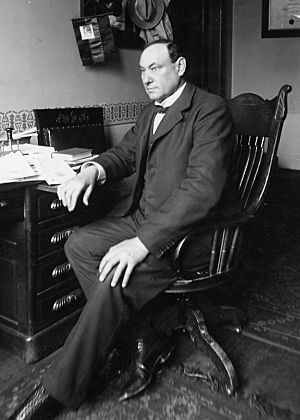Harvey Washington Wiley facts for kids
Quick facts for kids
Harvey Washington Wiley
|
|
|---|---|
 |
|
| Born | October 18, 1844 Kent, Indiana, United States
|
| Died | June 30, 1930 (aged 85) Washington, D.C., United States
|
| Resting place | Arlington National Cemetery |
| Alma mater |
|
| Occupation |
|
| Years active | 1882–1930 |
| Known for |
|
| Spouse(s) | Anna Kelton |
| Parent(s) |
|
| Awards | Elliott Cresson Medal (1910) |
| Signature | |
 |
|
Harvey Washington Wiley (born October 18, 1844 – died June 30, 1930) was a very important American chemist. He is famous for leading the fight to create the Pure Food and Drug Act in 1906. This law made sure that the food and medicines we buy are safe and honest. He also became the first leader of the United States Food and Drug Administration (FDA), which still protects us today!
Contents
Early Life and Education
Harvey Wiley was born on October 18, 1844, in a log farmhouse in Kent, Indiana. His father was a farmer. In 1863, Harvey started college at Hanover College.
During the American Civil War, he decided to join the Union Army in 1864. He served as a corporal for about a year. After the war, he went back to Hanover College and finished his studies in 1867. He later earned a medical degree in 1871.
Wiley also taught Greek and Latin at Butler University. He then taught chemistry at the medical college, where he started Indiana's first chemistry lab course. After studying at Harvard University for a short time, he became a chemistry professor at Purdue University in 1874. He was also named the state chemist for Indiana.
Fighting for Safer Food
In 1878, Wiley traveled to Germany to learn more about chemistry. He studied how to use a special tool called a polariscope and learned a lot about sugar chemistry. When he returned to Purdue, the Indiana State Board of Health asked him to check sugars and syrups. They wanted to see if these products were "adulterated," meaning if anything fake or harmful had been added to them.
Wiley spent his last years at Purdue studying sorghum and sugar. He hoped to help the United States grow its own strong sugar industry. His first published paper in 1881 was about how sugar was being mixed with glucose, which was a type of adulteration.
Wiley believed that people deserved to know what was in their food and medicine. He worked hard to expose companies that were selling unsafe or fake products. His efforts led to the creation of the Pure Food and Drug Act in 1906. This law was a huge step in making sure that food and drugs sold in the U.S. were pure and correctly labeled.
Work at Good Housekeeping
After leaving his government job in 1912, Harvey Wiley continued his important work. He took charge of the laboratories at Good Housekeeping Magazine. Here, he kept fighting for the safety of everyday products that people bought. He worked with Good Housekeeping for 18 years, helping to protect consumers.
His Final Years
Harvey Wiley passed away at his home in Washington, D.C. on June 30, 1930. This was exactly 24 years after the Pure Food and Drug law was signed. He is buried in Arlington National Cemetery with his wife, Anna Kelton Wiley.
His Legacy
Harvey W. Wiley is remembered in many ways for his important work:
- A Liberty Ship named S.S. Harvey W. Wiley was built during World War II.
- The U.S. Post Office released a 3-cent postage stamp in his honor in 1956. This was to celebrate the 50th anniversary of the 1906 Pure Food and Drug Act.
- The Harvey W. Wiley Award is a top science award given each year by AOAC International. This group, which Wiley helped start, gives the award to scientists who make great contributions to testing methods.
- Several buildings are named after him, including residence halls at Hanover College and Purdue University. The main building for the FDA's food safety operations is also named the Harvey W. Wiley Federal Building.
- His birthplace in Indiana has a historic marker sign.
- The French government honored him in 1909, making him a Chevalier of the Order of the Légion d'honneur.
- Purdue University has a special teaching position called the Harvey Washington Wiley Distinguished Professor of Chemistry.
- Depictions of Harvey W. Wiley and advocation for the U.S. Pure Food and Drug Laws
-
Commemorative 50th Anniversary of Pure Food and Drug Laws stamp first issued by the U.S. Postal Service on June 27, 1956
Images for kids







